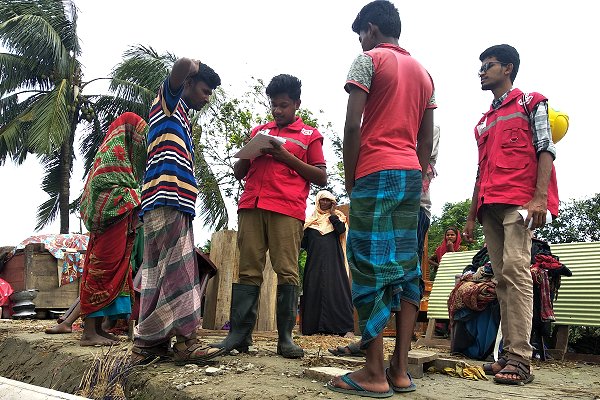
Bangladesh: How forecast-based financing supported objective decision-making in advance of Cyclone Fani

(This story appeared first yesterday on the IFRC news site. It has been edited slightly here for length.)
When a National Red Cross or Red Crescent Society receives a forecast of an imminent extreme weather event, one of their most urgent tasks is to decide what action to take in anticipation of a possible disaster.
In the case of the Bangladesh Red Crescent Society (BDRCS), this decision-making process has become clearer and more straightforward thanks to its improved use of scientific information, as was shown in recent weeks before the arrival of Cyclone Fani.
Since 2015, the Bangladesh Red Crescent has been using a forecast-based financing (FbF) approach with support from the German Red Cross.
As a result, when Cyclone Fani approached, decision-makers could rely on an established system which provided them with robust forecast information and served as a basis to decide when and where to act and with what resources.
Thanks to FbF there was a framework for decision-making,
and systematic monitoring of forecasts allowed
a focus on those districts later affected by rains
The Bangladesh National Society, with support from the German Red Cross and the Red Cross Red Crescent Climate Centre, had developed an early action protocol for cyclones.
This plan clearly defines forecast thresholds and details which early actions are needed, and where, to protect the population.
In the days before Cyclone Fani made landfall, the Bangladesh Red Crescent set up an activation committee in line with its established procedures for activating the protocol.
Its role was to continuously review the meteorological data and decide if according to the forecast information the trigger for activation was met.
The activation committee is chaired by the BDRCS Deputy Secretary General and also includes experts from the Cyclone Preparedness Programme, the Climate Centre, German Red Cross, and IFRC.
Stocktaking
Activation of the Bangladesh EAP is being funded by the IFRC’s financial mechanism, created in May 2018, to support early, forecast-based action by the DREF.
Based on the forecast information, the local branches in the coastal districts activated their control rooms, mobilized their resources, volunteers and officials for early warning and preparation of evacuation shelters.
Eight members of the National Disaster Response Team were deployed in four districts (Satkhira, Khulna, Bagerhat and Barguna) to support the activities being conducted.
In two districts, with German Red Cross support branches also undertook a rapid stocktaking of local markets to ascertain if they were able to supply the food and relief items that would be required in case of an activation.
Readiness
In addition, a database of the cyclone shelters, markets and accessibility was used by all stakeholders in preparation for Cyclone Fani.
The database had been developed by the FbF project and proved to be very useful in preparing districts in the cyclone’s path for evacuation, and in obtaining real-time information from the shelters through the contacts listed.
The activation committee met several times before deciding not to activate the EAP as the forecasts did not meet the defined trigger, and analysis suggested the forecast impact could be managed by the local branch.
Thanks to the work on FbF, there was a clear framework for decision-making, and the systematic monitoring of forecasts allowed preparations to focus on those districts that were later affected by rains, using resources efficiently.
All these actions as well as the structures for coordination demonstrate the importance of forecast-based financing in supporting readiness activities and bringing all affected parties together to take anticipatory action.
Bangladesh Red Crescent volunteers carrying out an assessment after Cyclone Fani, which made landfall in Odisha state in India on 3 May and moved through Bangladesh the next day, damaging houses and crops. (Photo: BDRCS)